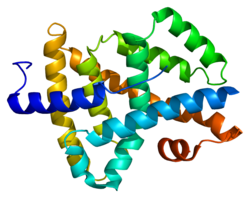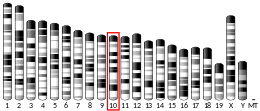Farnesoid_X_receptor
Farnesoid X receptor
Protein-coding gene in the species Homo sapiens
The bile acid receptor (BAR), also known as farnesoid X receptor (FXR) or NR1H4 (nuclear receptor subfamily 1, group H, member 4), is a nuclear receptor that is encoded by the NR1H4 gene in humans.[5][6]
FXR is expressed at high levels in the liver and intestine. Chenodeoxycholic acid and other bile acids are natural ligands for FXR. Similar to other nuclear receptors, when activated, FXR translocates to the cell nucleus, forms a dimer (in this case a heterodimer with RXR) and binds to hormone response elements on DNA, which up- or down-regulates the expression of certain genes.[6]
One of the primary functions of FXR activation is the suppression of cholesterol 7 alpha-hydroxylase (CYP7A1), the rate-limiting enzyme in bile acid synthesis from cholesterol. FXR does not directly bind to the CYP7A1 promoter. Rather, FXR induces expression of small heterodimer partner (SHP), which then functions to inhibit transcription of the CYP7A1 gene. In this way, a negative feedback pathway is established in which synthesis of bile acids is inhibited when cellular levels are already high.
The absence of FXR in an FXR-/- mouse model led to increased bile acids in the liver, and the spontaneous development of liver tumors.[7] Reducing the pool of bile acids in the FXR-/- mice by feeding the bile acid sequestering resin cholestyramine reduced the number and size of the malignant lesions.
FXR has also been found to be important in regulation of hepatic triglyceride levels.[8] Specifically, FXR activation suppresses lipogenesis and promotes free fatty acid oxidation by PPARα activation.[8] Studies have also shown the FXR to regulate the expression and activity of epithelial transport proteins involved in fluid homeostasis in the intestine, such as the cystic fibrosis transmembrane conductance regulator (CFTR).[9]
Activation of FXR in diabetic mice reduces plasma glucose and improves insulin sensitivity, whereas inactivation of FXR has the opposite effect.[8]
Farnesoid X receptor has been shown to interact with:
A number of ligands for FXR are known, of both natural and synthetic origin.[12][13][14]
- Agonists
- Cafestol[15]
- Chenodeoxycholic acid
- Fexaramine
- GW 4064[16]
- Ivermectin[17][18]
- Obeticholic acid
- Tropifexor
- Antagonists
- "Human PubMed Reference:". National Center for Biotechnology Information, U.S. National Library of Medicine.
- "Mouse PubMed Reference:". National Center for Biotechnology Information, U.S. National Library of Medicine.
- Forman BM, Goode E, Chen J, Oro AE, Bradley DJ, Perlmann T, Noonan DJ, Burka LT, McMorris T, Lamph WW, Evans RM, Weinberger C (Jun 1995). "Identification of a nuclear receptor that is activated by farnesol metabolites". Cell. 81 (5): 687–93. doi:10.1016/0092-8674(95)90530-8. PMID 7774010.
- Yang F, Huang X, Yi T, Yen Y, Moore DD, Huang W. Spontaneous development of liver tumors in the absence of the bile acid receptor farnesoid X receptor. Cancer Res. 2007 Feb 1;67(3):863-7. doi: 10.1158/0008-5472.CAN-06-1078. PMID 17283114
- Jiao Y, Lu Y, Li XY (Jan 2015). "Farnesoid X receptor: a master regulator of hepatic triglyceride and glucose homeostasis". Acta Pharmacologica Sinica. 36 (1): 44–50. doi:10.1038/aps.2014.116. PMC 4571315. PMID 25500875.
- Mroz MS, Keating N, Ward JB, Sarker R, Amu S, Aviello G, Donowitz M, Fallon PG, Keely SJ (May 2014). "Farnesoid X receptor agonists attenuate colonic epithelial secretory function and prevent experimental diarrhoea in vivo" (PDF). Gut. 63 (5): 808–17. doi:10.1136/gutjnl-2013-305088. PMID 23916961. S2CID 15778582.
- Zhang Y, Castellani LW, Sinal CJ, Gonzalez FJ, Edwards PA (Jan 2004). "Peroxisome proliferator-activated receptor-gamma coactivator 1alpha (PGC-1alpha) regulates triglyceride metabolism by activation of the nuclear receptor FXR". Genes & Development. 18 (2): 157–69. doi:10.1101/gad.1138104. PMC 324422. PMID 14729567.
- Seol W, Choi HS, Moore DD (Jan 1995). "Isolation of proteins that interact specifically with the retinoid X receptor: two novel orphan receptors". Molecular Endocrinology. 9 (1): 72–85. doi:10.1210/mend.9.1.7760852. PMID 7760852.
- Fiorucci S, Zampella A, Distrutti E (2012). "Development of FXR, PXR and CAR agonists and antagonists for treatment of liver disorders". Current Topics in Medicinal Chemistry. 12 (6): 605–24. doi:10.2174/156802612799436678. PMID 22242859.
- Fiorucci S, Mencarelli A, Distrutti E, Zampella A (May 2012). "Farnesoid X receptor: from medicinal chemistry to clinical applications". Future Medicinal Chemistry. 4 (7): 877–91. doi:10.4155/fmc.12.41. PMID 22571613.
- Ricketts ML, Boekschoten MV, Kreeft AJ, Hooiveld GJ, Moen CJ, Müller M, Frants RR, Kasanmoentalib S, Post SM, Princen HM, Porter JG, Katan MB, Hofker MH, Moore DD (Jul 2007). "The cholesterol-raising factor from coffee beans, cafestol, as an agonist ligand for the farnesoid and pregnane X receptors". Molecular Endocrinology. 21 (7): 1603–16. doi:10.1210/me.2007-0133. PMID 17456796.
- Zhang, S.; Pan, X.; Jeong, H. (2015). "GW4064, an Agonist of Farnesoid X Receptor, Represses CYP3A4 Expression in Human Hepatocytes by Inducing Small Heterodimer Partner Expression". Drug Metabolism and Disposition. 43 (5): 743–748. doi:10.1124/dmd.114.062836. PMC 4407707. PMID 25725071.
- Carotti A, Marinozzi M, Custodi C, Cerra B, Pellicciari R, Gioiello A, Macchiarulo A (2014). "Beyond bile acids: targeting Farnesoid X Receptor (FXR) with natural and synthetic ligands". Current Topics in Medicinal Chemistry. 14 (19): 2129–42. doi:10.2174/1568026614666141112094058. PMID 25388537. Archived from the original on 2021-10-19.
- Jin L, Feng X, Rong H, Pan Z, Inaba Y, Qiu L, et al. (2013). "The antiparasitic drug ivermectin is a novel FXR ligand that regulates metabolism". Nature Communications. 4: 1937. Bibcode:2013NatCo...4.1937J. doi:10.1038/ncomms2924. PMID 23728580.
- Kalaany NY, Mangelsdorf DJ (2006). "LXRS and FXR: the yin and yang of cholesterol and fat metabolism". Annual Review of Physiology. 68: 159–91. doi:10.1146/annurev.physiol.68.033104.152158. PMID 16460270.
- Kuipers F, Stroeve JH, Caron S, Staels B (Jun 2007). "Bile acids, farnesoid X receptor, atherosclerosis and metabolic control". Current Opinion in Lipidology. 18 (3): 289–97. doi:10.1097/MOL.0b013e3281338d08. PMID 17495603. S2CID 7385142.
- Seol W, Choi HS, Moore DD (Jan 1995). "Isolation of proteins that interact specifically with the retinoid X receptor: two novel orphan receptors". Molecular Endocrinology. 9 (1): 72–85. doi:10.1210/mend.9.1.7760852. PMID 7760852.
- Zavacki AM, Lehmann JM, Seol W, Willson TM, Kliewer SA, Moore DD (Jul 1997). "Activation of the orphan receptor RIP14 by retinoids". Proceedings of the National Academy of Sciences of the United States of America. 94 (15): 7909–14. Bibcode:1997PNAS...94.7909Z. doi:10.1073/pnas.94.15.7909. PMC 21528. PMID 9223286.
- Makishima M, Okamoto AY, Repa JJ, Tu H, Learned RM, Luk A, Hull MV, Lustig KD, Mangelsdorf DJ, Shan B (May 1999). "Identification of a nuclear receptor for bile acids". Science. 284 (5418): 1362–5. Bibcode:1999Sci...284.1362M. doi:10.1126/science.284.5418.1362. PMID 10334992.
- Parks DJ, Blanchard SG, Bledsoe RK, Chandra G, Consler TG, Kliewer SA, Stimmel JB, Willson TM, Zavacki AM, Moore DD, Lehmann JM (May 1999). "Bile acids: natural ligands for an orphan nuclear receptor". Science. 284 (5418): 1365–8. Bibcode:1999Sci...284.1365P. doi:10.1126/science.284.5418.1365. PMID 10334993.
- Bramlett KS, Yao S, Burris TP (Dec 2000). "Correlation of farnesoid X receptor coactivator recruitment and cholesterol 7alpha-hydroxylase gene repression by bile acids". Molecular Genetics and Metabolism. 71 (4): 609–15. doi:10.1006/mgme.2000.3106. PMID 11136553.
- Stegh AH, Barnhart BC, Volkland J, Algeciras-Schimnich A, Ke N, Reed JC, Peter ME (Feb 2002). "Inactivation of caspase-8 on mitochondria of Bcl-xL-expressing MCF7-Fas cells: role for the bifunctional apoptosis regulator protein". The Journal of Biological Chemistry. 277 (6): 4351–60. doi:10.1074/jbc.M108947200. PMID 11733517.
- Cui J, Heard TS, Yu J, Lo JL, Huang L, Li Y, Schaeffer JM, Wright SD (Jul 2002). "The amino acid residues asparagine 354 and isoleucine 372 of human farnesoid X receptor confer the receptor with high sensitivity to chenodeoxycholate". The Journal of Biological Chemistry. 277 (29): 25963–9. doi:10.1074/jbc.M200824200. PMID 12004058.
- Huber RM, Murphy K, Miao B, Link JR, Cunningham MR, Rupar MJ, Gunyuzlu PL, Haws TF, Kassam A, Powell F, Hollis GF, Young PR, Mukherjee R, Burn TC (May 2002). "Generation of multiple farnesoid-X-receptor isoforms through the use of alternative promoters". Gene. 290 (1–2): 35–43. doi:10.1016/S0378-1119(02)00557-7. PMID 12062799.
- Pineda Torra I, Claudel T, Duval C, Kosykh V, Fruchart JC, Staels B (Feb 2003). "Bile acids induce the expression of the human peroxisome proliferator-activated receptor alpha gene via activation of the farnesoid X receptor". Molecular Endocrinology. 17 (2): 259–72. doi:10.1210/me.2002-0120. PMID 12554753.
- Anisfeld AM, Kast-Woelbern HR, Meyer ME, Jones SA, Zhang Y, Williams KJ, Willson T, Edwards PA (May 2003). "Syndecan-1 expression is regulated in an isoform-specific manner by the farnesoid-X receptor". The Journal of Biological Chemistry. 278 (22): 20420–8. doi:10.1074/jbc.M302505200. PMID 12660231.
- Pircher PC, Kitto JL, Petrowski ML, Tangirala RK, Bischoff ED, Schulman IG, Westin SK (Jul 2003). "Farnesoid X receptor regulates bile acid-amino acid conjugation". The Journal of Biological Chemistry. 278 (30): 27703–11. doi:10.1074/jbc.M302128200. PMID 12754200.
- Zhao A, Lew JL, Huang L, Yu J, Zhang T, Hrywna Y, Thompson JR, de Pedro N, Blevins RA, Peláez F, Wright SD, Cui J (Aug 2003). "Human kininogen gene is transactivated by the farnesoid X receptor". The Journal of Biological Chemistry. 278 (31): 28765–70. doi:10.1074/jbc.M304568200. PMID 12761213.
- Barbier O, Torra IP, Sirvent A, Claudel T, Blanquart C, Duran-Sandoval D, Kuipers F, Kosykh V, Fruchart JC, Staels B (Jun 2003). "FXR induces the UGT2B4 enzyme in hepatocytes: a potential mechanism of negative feedback control of FXR activity". Gastroenterology. 124 (7): 1926–40. doi:10.1016/S0016-5085(03)00388-3. PMID 12806625.
- Holt JA, Luo G, Billin AN, Bisi J, McNeill YY, Kozarsky KF, Donahee M, Wang DY, Mansfield TA, Kliewer SA, Goodwin B, Jones SA (Jul 2003). "Definition of a novel growth factor-dependent signal cascade for the suppression of bile acid biosynthesis". Genes & Development. 17 (13): 1581–91. doi:10.1101/gad.1083503. PMC 196131. PMID 12815072.
- Claudel T, Inoue Y, Barbier O, Duran-Sandoval D, Kosykh V, Fruchart J, Fruchart JC, Gonzalez FJ, Staels B (Aug 2003). "Farnesoid X receptor agonists suppress hepatic apolipoprotein CIII expression". Gastroenterology. 125 (2): 544–55. doi:10.1016/S0016-5085(03)00896-5. PMID 12891557.
- Hsiao PW, Fryer CJ, Trotter KW, Wang W, Archer TK (Sep 2003). "BAF60a mediates critical interactions between nuclear receptors and the BRG1 chromatin-remodeling complex for transactivation". Molecular and Cellular Biology. 23 (17): 6210–20. doi:10.1128/MCB.23.17.6210-6220.2003. PMC 180928. PMID 12917342.
- Ryan KK, Tremaroli V, Clemmensen C, Kovatcheva-Datchary P, Myronovych A, Karns R, Wilson-Pérez HE, Sandoval DA, Kohli R, Bäckhed F, Seeley RJ (May 2014). "FXR is a molecular target for the effects of vertical sleeve gastrectomy". Nature. 509 (7499): 183–8. Bibcode:2014Natur.509..183R. doi:10.1038/nature13135. PMC 4016120. PMID 24670636.
- Chamoli, M., Rane, A., Foulger, A. et al. A drug-like molecule engages nuclear hormone receptor DAF-12/FXR to regulate mitophagy and extend lifespan. Nat Aging (2023). https://doi.org/10.1038/s43587-023-00524-9
- "Farnesoid X Receptor (NR1H4)". Nuclear Receptor Resource. Archived from the original on 2015-01-12. Retrieved 2015-01-12.
- farnesoid+X-activated+receptor at the U.S. National Library of Medicine Medical Subject Headings (MeSH)





